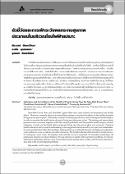บทคัดย่อ
โรงไฟฟ้าและเหมืองถ่านหินโรงไฟฟ้าแม่เมาะ อาจทำให้เกิดผลกระทบต่อสิ่งแวดล้อมและสุขภาพ แต่ในปัจจุบันยังไม่มีระบบเฝ้าระวังผลกระทบต่อสุขภาพของประชาชนที่อาศัยในบริเวณใกล้เคียงโรงไฟฟ้า การศึกษานี้เพื่อกำหนดตัวชี้วัดและแนวทางการเฝ้าระวังผลกระทบทางสุขภาพที่เหมาะสม โดยทำการทบทวนการทำเหมือง การผลิตกระแสไฟฟ้าจากถ่านหิน มลพิษที่เกี่ยวข้อง และความเป็นพิษของสารแต่ละตัว และทบทวนรายงานการศึกษาผลกระทบทางสุขภาพของประชาชนที่อาศัยในพื้นที่บริเวณโรงไฟฟ้าถ่านหิน ตัวชี้วัดและแนวทางการศึกษาได้ถูกตรวจสอบ โดยผู้เชี่ยวชาญและทุกฝ่ายที่เกี่ยวข้อง จากการศึกษาพบว่าเหมืองถ่านหินและโรงไฟฟ้าอาจทำให้เกิดสิ่งคุกคามสุขภาพได้หลายอย่าง ทั้งมลพิษทางอากาศ มลพิษทางน้ำ ทางเสียง ทางอุบัติเหตุ และสร้างความเดือดร้อนรำคาญ ตัวชี้วัดผลกระทบทางสุขภาพที่ควรเฝ้าระวัง คือ 1) สถิติการเข้ารับบริการที่ห้องฉุกเฉิน 2) การมาใช้บริการที่สถานบริการของรัฐ 3) การเฝ้าระวังการตาย 4) สภาพปอดของนักเรียน 5) การทำงานของปอดในผู้ใหญ่ที่มีปัญหาทางระบบการหายใจ 6) การป่วยเป็นโรคปอดอุดกั้นเรื้อรัง 7) การป่วยเป็นโรคปอดอักเสบของคนทำงานเหมืองถ่านหิน และ 8) ความเครียดและความเดือดร้อนรำคาญ
บทคัดย่อ
Mae-Moh Power Plant and Mae-Moh Lignite Mine may cause adverse environmental and health
effects. However, currently, there is no surveillance system to monitor the effects on the health of people
living near the power plant. This study is aimed at identifying indicators and studying the health impacts
in order to monitor the health status of people living near the power plant. The mining and power plant
processes were reviewed, together with their related pollutants and the possible health impacts of each
substance. A study on the health effects of people living near the power plant was reviewed. Practical
health indicators and a research methodology were suggested and reviewed by an expert and stakeholder.
It was found that these Mae-Moh facilities might produce several health hazards, including air pollutants,
water pollution, noise, accidents and other nuisances. The health indicators that should be monitored are:
(1) emergency room visits, (2) hospital visits and the services requested, (3) mortality monitoring, (4)
pulmonary function of school children, (5) lung function of adults with respiratory problems, (6) chronic
obstructive pulmonary disease cases, (7) pneumoconiosis among mine worker, and (8) stress and annoyance
due to the environmental problems.


